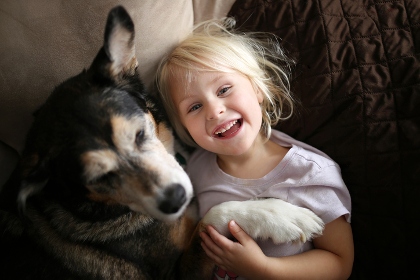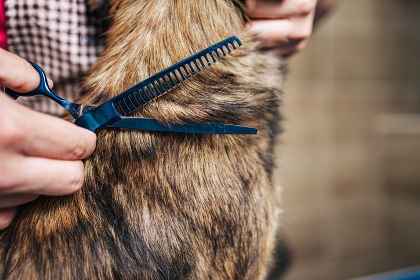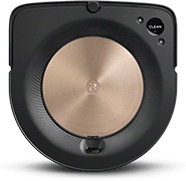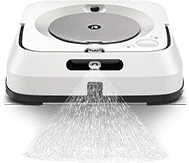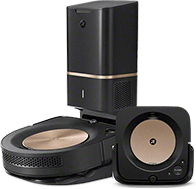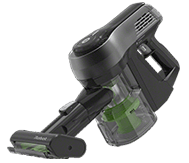19 Big Dogs That Don’t Shed & Tips For Reducing Shedding
You’ve always dreamt of having a big, fluffy dog. Or, maybe your kids are begging for one. Maybe you just happened to see a furry one in your neighborhood, and now have it in your head that you need a fluffers… but you aren’t sure yet.
You’re unsure of all the hair, and how to keep it off of your clothes, from settling into your rugs, and messing with your allergies.
There is a compromise though. Dozens of large dogs don’t shed very much, if at all, but they’re just as big and cuddly.
So, if you’re ready to love on a big furball, don’t worry, there are options for you. We have some of the furriest big dogs that don’t shed, below.
Large dog breeds we love to love
We’re big fans of big dogs. We sometimes bring our best dogs to the office (they’re a good reminder of one of the reasons we make robot vacuums – all the fur).
But even we acknowledge that one of the best ways to keep your home clean, and fur-free (or fur-reduced?) is to avoid the fur in the first place. If you love big dogs, as we do, then this poses a bit of an issue.
Unless you get one of these low-shed dog breeds…
1. The Giant Schnauzer
The Giant Schnauzer is a working dog, a hypoallergenic dog, and doesn’t shed. BUT they may still have some high-maintenance grooming needs due to their long hair.
Their wiry, thick coat of hair keeps them warm during colder seasons, and since it doesn’t shed, you’ll likely have to shave them down during the summer to keep them feeling cool and their coat looking nice.
2. The Afghan Hound
Though the Afghan Hound is known for its extremely long, luscious locks (even longer than the notorious golden hair of the retriever), it’s a hypoallergenic dog. They were bred in the high mountains as hunting dogs (which means they’ll need some very regular exercise), so rarely needed to shed.
That said, there is a level of grooming they still require, due to that long, silky hair (which has often put them into the category of a luxury dog). This means regular brushing- at least once a week- to keep their fur from tangles and matting. It’ll also remove debris that may get caught in the long hair.
3. The Barbet
They’re extremely sweet and love lots of affection– and may even get separation anxiety if left alone for too long.
They’re hypoallergenic dogs, but because they have a woolly coat, they’ll need occasional grooming. The lack of shedding (and the wooly nature of the fur) means all that hair gets trapped on them, and mats easily. By grooming, their fur will look silkier, and shinier, and their skin will be healthier.
4. The Xoloitzcuintli (or Xolo)
The Xolo is a very clean “hairless” dog breed, because of their very, very short coat. Even if they have that very fine layer of fur, it’s a single coat that doesn’t shed very often.
They’re fairly active dogs though, so if your lifestyle doesn’t fit their energy, they may not be for you. Despite the activity level, they’re extremely loyal dogs that read human emotions well, often making them great emotional companions for therapy.
5. The Black Russian Terrier
Black Russian Terriers, which are often confused with Giant Schnauzers, are not considered a hypoallergenic dog breed, though they are low shedders.
Their fur is fairly thick and puffy, which adds to the love most people have for their very family-oriented demeanor (they can become very attention-seeking).
Why is my dog shedding so much? And how can I deal with it?
These tips will get your shedding situation under control
Bathing them isn’t very easy, since their dense undercoat doesn’t get wet. They’re also one of the more expensive dogs to send to the groomer, since the double coat is so thick and shaggy, and they’re rather large dogs.
6. The Belgian Malinois
Similar in both appearance and demeanor to the German Shepherd, the Belgian Malinois is known as a rather daring and brave dog. But unlike the long-haired German Shepherd, the Malinois is a hypoallergenic breed with short hair. Highly energetic, these pups need lots of exercise, and thrive in larger environments. With strong training, the Belgian Malinois will be devoted to you for life.
Though their hair is short, they’ll still need some grooming due to a thicker undercoat that’ll matt and possibly cause heat bumps in the summer.
7. The Airedale Terrier
Gentle with children, intelligent, and active, the Airedale Terrier is a fun dog for families. They’re also one of the easiest to manage because their hair is short and wiry.
They also don’t have as much oil in their wiry coat, leading to less dander along with their low-shed nature. Ultimately, if you have allergies, they’re one of the better choices.
8. The Poodle (Standard Poodle)
Not all poodles are very large, and there are dozens of crossbreeds due to the demand for their hypoallergenic nature, short, tight curly coat, and lack of that typical dog smell.
No matter the size though, they’ll still need some trips to the groomer, since their hair can easily mat and grows long, fast. They also have a tendency to develop atopic dermatitis if their skin and hair aren’t properly cared for.
9. The Goldendoodle
Goldendoodles are extremely friendly and loyal dogs that are easy to train. With their curly coat, they can be irresistible. Goldendoodles are often confused with or compared to Labradoodles, both have excellent dispositions, and both are excellent family dogs. Labradoodles are great as hunting companions. Whereas Goldendoodles are extremely popular therapy dogs. They also happen to be hypoallergenic thanks to the poodle part of their DNA
10. The Komondor
A trusted watchdog, the Komondor is not hypoallergenic, but that doesn’t mean they shed like a typical dog, either. Their hair is thick and cord-like (similar to dreadlocks), and rather shaggy (they’re akin to a traditional mop-head).
They may lose a cord of hair every once in a while, which is why they aren’t categorized as hypoallergenic, but their level of shedding is far lower than the average dog.
As for their nature– they’re shepherd dogs and therefore are very good guardians and loyal to their property. Still, they’re playful and energetic, making them a fun option for young families.
11. The Portuguese Water Dog
Nature-born swimmers– hence their name– with a lot of intelligence that makes them easy to train, they’re often used as outdoor companions, show dogs, and emotional support animals. Portuguese Water Dogs are incredibly loving and make for great companions.
Unlike most dogs on this list, their hair can either become curly or wavy. Either way, it’ll only ever come in a single coat. Though still long, they don’t shed much, and any hair they do shed gets caught in their curly coat or wavy, long locks. Because of this, they’ll need occasional grooming to get rid of the dead hair.
12. The Bouvier Des Flandres
A giant herding dog, the Bouvier is extremely intelligent and trainable. They’re also very well-tempered.
As for their hair… It’s extremely long, though they don’t shed much. When grooming, it’s all about the head. If you’re grooming them at home, you never want to cut their large beard, simply brush it out extensively with a thinning sheer (especially around the corner of their eye).
 13. The Irish Water Spaniel
13. The Irish Water Spaniel
One of the largest and oldest breeds of Spaniel, they have a long-held reputation for being boisterous clowns. Adding to that characterization are their long, curly coat and floppy ears (a lot of that hair rests on the top of their head).
That curly coat– and their body shape– often gets them mixed up with poodles. Unlike the poodle, they don’t typically need a lot of trimming to keep their hair at a good and comfortable length.
That said, because they’re a crossbreed between the poodle and golden retriever, some dogs may be less or more hypoallergenic than others.
14. The Saluki
While the Saluki is not classified as a hypoallergenic dog, they’re very low shedders, and thus low on allergens. They also don’t have the typical dog smell, making them ideal for small homes or anyone with allergies (or that just doesn’t like their furniture to smell like a dog).
While they don’t shed much on their own, their hair does come out easily, especially around the ears, during grooming. If you want to keep their hair intact, don’t use a sheering brush on them. Instead, choose a regular hairbrush, and brush very gently or the hair will become thin.
15. The Peruvian Inca Orchid
The Peruvian Inca Orchid is a completely hairless dog, though they may sometimes have a very fine, thin layer of hair (more like peach fuzz), and some may have a long tuft of hair on their head.
This makes them almost completely hypoallergenic– no dog is entirely hypoallergenic, though, since it’s their dander, saliva, and oil that cause allergies.
16. The Wheaten Terrier
The Soft Coated Wheaten Terrier is very sociable, lively, congenial, and loves playtime. Originally bred as farm dogs in Ireland, they’re very trainable and don’t shed very much (they also don’t drool much, so, bonus).
They have a distinctive long beard under their muzzle and thin hair that sometimes covers their eyes. While they’re hypoallergenic, their long, silky, wavy coat can often pick up some debris, which is why they’ll need regular grooming.
17. The Vizsla
The Vizsla isn’t classified as a hypoallergenic dog, but they are a very short-haired dog and are a common choice for dog owners with allergies, even though they still shed. Their hair is just so short that it goes almost completely unnoticed around your home (at least not like most dog hair).
Another benefit that reduces shedding is their lack of an undercoat. Without a double coat, they do get a little cold in chillier climates, but they love being pampered so won’t mind you indulging in a few cute outfits.
 18. The Basenji
18. The Basenji
The Basenji isn’t a massive dog. It almost errs on the medium side, but it can still get as large as 17 inches tall and, of course, it’s non-shedding. It has very short hair with patterns and colors similar to a basset hound.
We couldn’t resist including this breed, since it’s considered a “cat-like” dog, with grooming habits far beyond the typical dog. This, along with their short hair, means they don’t need a ton of grooming (yay, savings).
They do shed, though less than many dogs (they’re classified as low-shedding), but their hair is so short and thin that it’s hard to notice it around your home.
19. Scottish Terrier
The Scottish Terrier is a low-shedding dog, despite having both a top coat and undercoat. The topcoat is notably wiry and even a little hard. The undercoat is softer, though very dense.
Because they don’t shed as much as other dogs, but they do have a double coat, they’ll need regular grooming to get rid of that excess hair in their undercoat.
Remove pet hair and avoid pet accidents, guaranteed!
Try our iRobot® Roomba® j7 Robot Vacuum
What is the largest non-shedding dog breed?
The largest non-shedding dog breed isn’t something that’s commonly measured, and there’s no set answer since many breeds are cross-bred and each dog may be smaller or larger than average for their kind.
That said, some breeds trend much larger than others. The non-shedding dog breeds that stand out (literally), are:
- The Airedale Terrier is the largest terrier breed, sometimes even referred to as the “King of the Terriers”. Grows to around 23 inches. Not the tallest on this list, but the tallest of their breed.
- The Afghan Hound is a hunting dog bred for mountainous regions. It’s among the largest of the non-shedding breeds, and its long coat makes it look even larger. They grow up to 27 inches.
- The Giant Schnauzer an excellent watchdog, is the largest in the Schnauzer breed (and much larger than the standard schnauzer), and it lives up to its name since it’s a working dog and was bred to herd large cattle. They grow to around 28 inches tall.
- The Komondor is another herding dog and was often bred to withstand attacks against wolves and to remain comfortable in colder temperatures, so they’re pretty hardy. This beautiful working dog can grow to around 26 inches tall.
There’s just something about having a really large dog– especially the ones that THINK they’re small dogs and turn into cuddle bugs that roll all over your lap. If you’re someone who wants a really large dog without all the shedding, the dogs mentioned above are for you.
What is the calmest non-shedding dog?
Most large dogs aren’t considered calm, and that’s because a lot of them are working dogs, bred from herding and hunting dogs. These big dogs were meant to be outside, running around farms, warding off attacks from predators, and keeping up with very active dog owners.
Many of them were also raised in very cold and mountainous areas, which means they don’t shed much despite most of them having a double coat, with very dense undercoats.
That said, there are a few big dogs that are a bit on the demure side, such as:
- The Basenji is sometimes called “the barkless dog” (though they tend to “yodel” instead). As very affectionate dogs, they’re family dogs, simply content with cuddling with their human family rather than bouncing around uncontrollably.
- The Saluki is a very calm dog, and can even be a bit shy around people and environments they don’t know. Though they are not lap dogs, they’re very content with sitting by your legs for a long and easy day.
- The Goldendoodle is one of the most common household dogs due to its hypoallergenic, yet calm nature. They’re incredibly loving and easy-going with both children and other dogs, and though they can be energetic, they’re typically calm around people and easy to manage.
- The military bred the Black Russian Terrier, making it tolerant of stressful situations, with very stable nervous systems. They’re sometimes even considered tranquil.
Tips for reducing shedding (and the effects of dander) for big dog breeds

If finding the occasional fur ball around your home isn’t your thing, or you have allergies, there are several ways you can reduce the amount of shedding from your dog (yes, even hypoallergenic dogs), and the amount of fur around your home.
Tip #1: Prevent the shedding of fur, and keep your dog healthier
Believe it or not, you can prevent some shedding. You can’t make all of it go away, but choosing a hypoallergenic dog, along with some preventative measures can go a long way.
One way to prevent hair is by making sure that your dog is in top health.
Dogs naturally shed, and they’ll shed even more during the shedding seasons (spring going into summer, and fall going into winter). But, they’ll shed far more throughout the year for certain reasons, such as:
- The lack of certain nutrients in their dog food
- A skin infection
- They have fleas or a parasite
- Digestive issues
- Skin irritation caused by certain shampoos
This is, by no means, an exhaustive list of reasons your dog may be shedding more than usual, but it’s a great place to start!
Note: If your dog is shedding more than normal or shedding excessively, consider taking them to the vet.
We found 21 of the best pet hair remover tools
That said, there are a few ways you can boost the sheen and health of your dog and their fur, such as:
- Feeding them wet food at least once a day, as it typically contains more water, fiber, and nutrients for a healthy coat (and dogs sometimes struggle to take in enough water)
- Brushing their hair once a week with an appropriate pet grooming tool for their type of coat
- Giving them vitamins, such as omegas and fatty acids (coconut oil and molasses are good sources for dogs) can also improve the health of their skin, which in turn improves their fur (just remember to consult your vet before giving your dog any vitamins, supplements, or foods not specifically designed for dogs)
- Giving your dog a regular bath, or sending them to the groomer regularly, can drastically reduce the amount of hair left on their skin, and makes removing the dead hair a lot easier.
Tip #2: Use an air purifier
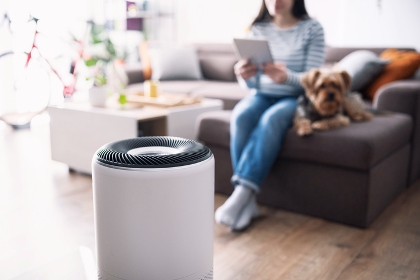
While an air purifier won’t get the hair that’s stuck in your carpet or couch (try a Roomba® H1 Handheld vacuum cleaner for that), it’s a place to start. For reducing pet dander, air purifiers can be very effective, especially purifiers with a HEPA filter. HEPA filters can remove super tiny particles, which are smaller than pet dander.
If you’re an allergy-sufferer, an air purifier is not only a great way to reduce the fur and dander floating around your home (dander harbors a particular protein from your dog’s skin, and that’s what causes your pet-related allergies), but it will also help to reduce any dog-related smells.
You can have a pet and clean air too!
Our air purifiers clean your indoor air every 15 minutes
Tip #3: Use the right de-shedding tool
There are far more de-shedding tools out there than you may realize, and they’re not all created equal. Or rather, not all are created for universal brushing across all breeds.
Using the wrong brush may result in removing too much of your dog’s hair, thinning it, and making it harder for the hair to grow back. Grooming should also be a calming experience for your dog. Using a brush that’s too harsh on their coat can be uncomfortable, or even painful. Since we all love those thick, luscious locks, and we want our dogs to enjoy being groomed, finding the right brush is a good move.
What kind of dog brushes are we talking about? Here’s what to look out for:
- Undercoat rake: This is likely the brush you’ll use the most for many of the dogs on the list above. It has long wires, though only a few of them (they’re more spread out), looking similar to a pin brush or a hairbrush you might use on your locks.
- Slicker brush: you’d likely recognize this brush, as it’s one of the most common types of grooming tools on the market. Because of that, it’s also one that most people will instinctively reach for first. It has a padded head with rows of very thin wire bristles and is used to detangle hair.
- Shedding blade: this one is a bit more common for groomers to use than anyone else, but it can help to cut down those thick undercoats. It has a thin-bladed loop, tied together by the handle.
- Pin brush: Pin brushes look very similar to regular hairbrushes, but work excellently to detangle fur, and even get out debris or bugs in their hair or on their skin.
- Bristle brush: is one of the thickest brushes for dogs and the one with the softest bristles too. It looks very similar to a baby brush, with the long, thin, and gentle bristles that are densely clustered.
It’s best used for brushing sensitive areas of a dog (such as their face), for brushing out the thinner topcoat on your dog, and helping to distribute their natural hair oil (which can keep their hair shiny and reduce shedding).
Bonus Tip: Use the right pet hair removal tools around your home
Keeping your home clean and free of pet dander and fur requires a bit of cleaning, especially around the places where hair gathers the most- furniture and carpet.
To effectively remove all that hair, you’re going to need the right pet hair removal tools.
Some essential tools to keep on hand:
- Lint roller (it may say it’s for lint, but it’s most definitely for pet hair)
- Pet hair dryer sheets
- Silicone brushes (the friction from the silicone attracts the hair with static)
- Short, handheld wire rake for your carpet
- Silicone broom (essentially the same as the silicone brushes, only large for bigger areas)
- Roomba® H1 Handheld vacuum cleaner
- Any Roomba® vacuum cleaner for your hardwood and carpet
Keeping your home clean, and your dog healthy and groomed are your best options for reducing hair beyond getting a hypoallergenic pooch.
Hopefully, you find a dog on this list that resonates with your lifestyle and meets the criteria you’re looking for, because they deserve a good home, and you deserve a loving pet.

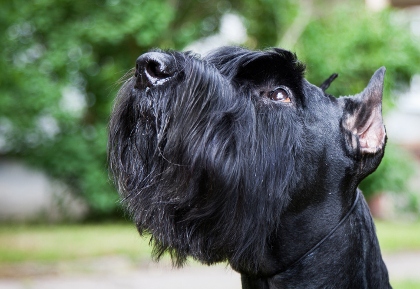
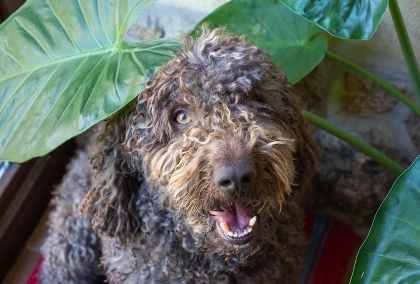
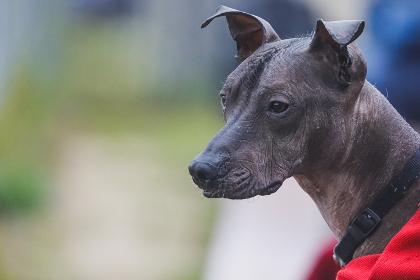

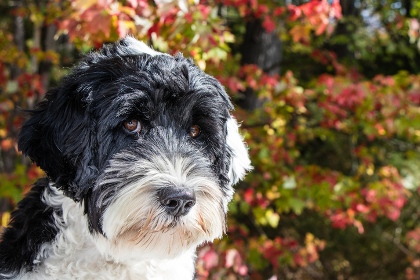
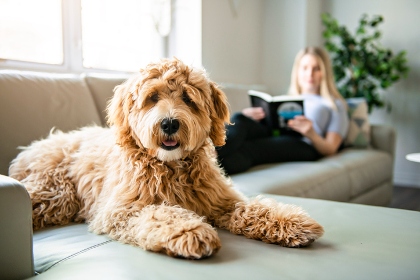 13. The Irish Water Spaniel
13. The Irish Water Spaniel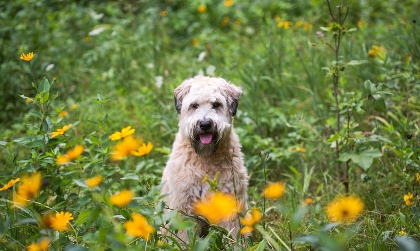
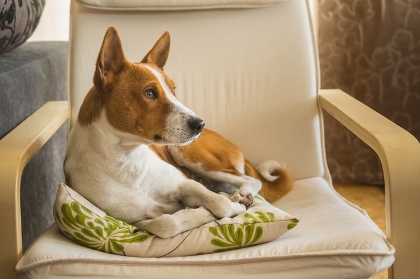 18. The Basenji
18. The Basenji